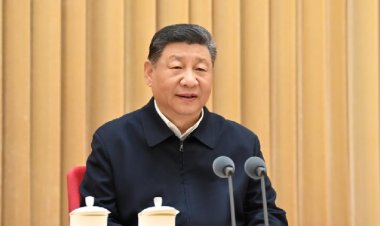Rich countries unite against China ... sort of
Under pressure from the U.S., the G7 is rolling out new initiatives to counter China's economic reach. There's little agreement on how much further to go.


FASANO, Italy — President Joe Biden and fellow G7 leaders agree that China poses a grave threat to their economies.
But behind the group’s collective bravado on “getting tough” with China, the countries still have varying appetites for how far to actually go in challenging a world superpower — differences that some officials worry could dent the coalition’s ability to fend off Beijing’s advances.
The G7 on Friday will try to paper over those lingering divides, coalescing behind a series of initiatives aimed at ratcheting up attention on China’s trade and investment in developing countries around the globe.
That comes after the U.S. has sought to apply maximum pressure on the Chinese in recent years, hitting Beijing with heavy tariffs and accusing it of unfair trade practices. While Europe harbors its own deep concerns about China’s expanding power, it has taken a more cautious approach, tempered by concerns about its own vulnerability to economic retaliation. The disparity threatens to hamper the goal of forming a united front so strong that China has little choice but to back down.
“It’s just always going to be a struggle,” said one former administration official who worked on Biden’s trade agenda, granted anonymity to discuss the diplomatic dynamics. “All countries like investment. But at what cost?”
On Friday, the global allies are expected to agree on the need to more forcefully combat China’s overcapacity, senior officials here said, and are committing billions more dollars towards their own investments in emerging economies, something China has been doing on a large scale for years. The U.S. during the summit also expanded a set of sanctions aimed in part at China, which it has accused of supplying Russia in its war against Ukraine.
“China does not supply weapons, but the ability to produce those weapons and the technology available to do it,” Biden said on Thursday. “So it is, in fact, helping Russia.”
Those deliberate steps represent the latest in a notable shift within the coalition driven largely by the U.S.’s increasing hawkishness toward China — a posture taken by former President Donald Trump that Biden has since advanced.
“One hundred percent, that is a major part of the motivation,” said a senior administration official, who was granted anonymity to describe G7 discussions. “We need a response” to China’s industrial policies and aggressive trade practices.
Biden, however, has taken a more nuanced approach to the U.S. trade war with China than his predecessor, who advocated blanket tariffs on Chinese imports regardless of the economic impact. Biden administration officials hope the more surgical trade measures will help convince other countries to follow suit. During a closed-door meeting with the Business Roundtable on Thursday, White House chief of staff Jeff Zients stressed the need to avoid a go-it-alone strategy on China, even as the U.S. intensifies its own competition with the country, according to a person in the room, who was granted anonymity to describe private remarks.
The White House in May quadrupled tariffs on over a dozen Chinese products, including electric vehicles — but officials were quick to note that the central goal was to protect emerging industries, not reshape existing ones. It has also encouraged other allies to boost their own economic spending, similar to the U.S.’s new investments in domestic manufacturing.
“Our goal here is to take targeted action with our allies and partners in the hope that China will change their behavior,” Deputy Treasury Secretary Wally Adeyemo said in an interview.
Still, current and former officials say despite the rhetorical agreement over the need to take on China, convincing U.S. allies to take aggressive and concrete steps remains a work in progress. European countries have largely shied away from slapping their own tariffs on Chinese goods, preferring not to risk direct conflict with a nation that could retaliate with its own damaging economic offensive.
They have also hewed closely to rules set by the World Trade Organization that limit the types of trade defense measures countries are allowed to deploy — a constraint that the U.S. has repeatedly ignored.
The one major action the continent has taken — new European Commission duties on Chinese electric cars announced last week — represents just a fraction of the cost that the U.S. is imposing on those imports. The Commission’s planned tariff increase — from 17 to 38 percent — may not even be high enough to keep the vehicles out of Europe because of the massive subsidies that Chinese automakers receive, said Greta Peisch, a former Biden administration U.S. trade official.
“It appears that [Chinese automakers] have quite a bit of room to reduce their profit margin, to pay that tariff and still have space, essentially, to keep their prices the same,” she said.
In the U.S., current and former officials say they recognize that European nations are less insulated from the risk of Chinese retaliation — and that they’ve already come a long way in their willingness to side more firmly against an economic superpower. Europe is also eyeing other measures to bolster the continent’s industries, even as countries like France have at times bristled at the U.S.’s own push to revitalize domestic manufacturing.
There’s much more to do, the White House acknowledges. China remains determined to expand its economic influence by any means necessary, U.S. officials warn, requiring an increasing dedication among the West’s wealthiest democracies to counter it. Acknowledging the challenge, as the G7 has now done is a start; the next test is how well — and how uniformly — the group follows through.
“This administration, like no other, knows that when you take direct action against China, they’ll try to find another way around it,” the former administration official said. “But we’ve seen this before where if you wait and wait, next thing you know, you don’t have a solar industry. Next thing you know, your steel industry is on life support.”












